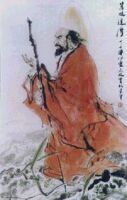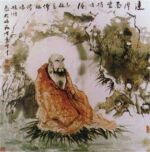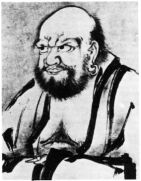The Teaching of Bodhidharma
"Barbarian from the West"
|
Bodhidharma followed Prajnatara's suggestion, crossing the Yangtze River
into northern China and arriving at the Shaolin monastery, where he taught
for nine years and developed four main disciples, one of whom became
enlightened. That was Hui-k'o.
Bodhidharma's
Discourse on the Twofold Entrance to the Tao (from
The Golden Age of Zen by John C.H. Wu):
There are many roads leading to the Tao, but essentially they can be subsumed under two
categories. The one is 'Entrance by way of Reason,' and the other 'Entrance by the way of Conduct.'
By 'Entrance by
way of Reason' we mean the understanding of the fundamental doctrines through
the study of the scriptures, the realization, upon the basis of a deep-rooted
faith, that all sentient beings have in common the one True Nature, which does
not manifest itself clearly in all cases only because it is overwrapped
by external objects and false thoughts. If a man abandons the false and
returns to the true, resting single-heartedly and undistractedly in pure
contemplation, he will realize that there is neither self nor other, that the
holy and profane are of one essence. If he holds on firmly to this belief
and never swerves from it, he will never again be a slave to the letter of
the scriptures, being in secret communion with Reason itself and altogether
emancipated from conceptual discrimination. In this way, he will enjoy
perfect serenity and spontaneity. This is called 'Entrance by way of Reason.'
'Entrance by way
of Conduct' refers to the four rules of conduct under which all other rules
can be subsumed. They are (1) the rule of requital of hatred, (2) the rule
of adaptation to variable conditions and circumstances of life, (3) the rule
of non-attachment, and (4) the rule of acting in accord with the Dharma.
1. The
Requital of Hatred. When a pursuer of the Tao falls into any kind of
suffering and trials, he should think and say to himself thus: 'During the
innumerable past kalpas I have abandoned the essential and followed after the
accidentals, carried along on the restless waves of the sea of existences,
and thereby creating endless occasions for hate, ill-will, and wrong-doing.
Although my present suffering is not caused by any offenses committed in this
life, yet it is a fruit of my sins in my past existences, which happens to
ripen at this moment. It is not something which any men or gods could have
given to me. Let me therefore take, patiently and sweetly, this bitter fruit
of my own making without resentment or complaint against anyone.' The
Scripture teaches us not to be disturbed by painful experiences. Why?
Because of a penetrating insight into the real cause of all our sufferings.
When this mind is awakened in a man, it responds spontaneously to the
dictates of Reason, so that it can even help him to make the best use of
other people's hatred and turn it into an occasion of advance toward the Tao.
This is called the 'rule of requital of hatred.'
|
2. The Rule of
Adaptation. We should know that all sentient beings are produced by the
interplay of karmaic conditions, and as such there can be no real self in
them. The mingled yarns of pleasure and pain are all woven of the threads of
conditioning causes. If therefore I should be rewarded with fortune, honor
and other pleasant things, I must realize that they are the effects of my
previous deeds destined to be reaped in this life. But as soon as their
conditioning causes are exhausted, they will vanish away. Then why should I
be elated over them? Therefore, let gains and loses run their natural
courses according to the ever-changing conditions and circumstances of life,
for the Mind itself does not increase with the gains nor decrease with the
losses. In this way, no gales of self-complacency will arise, and your mind
will remain in hidden harmony with the Tao. It is in this sense that we must
understand 'the rule of adaptation to the variable conditions and
circumstances of life.'
4. The Rule of
acting in accord with the Dharma. Dharma is nothing else than Reason
which is pure in its essence. This pure Reason is the formless Form of all
Forms; it is free of all defilements and attachments, and it knows of neither
'self' nor 'other.' As the Scripture says, 'In the Dharma there are no
sentient beings, that is, it is free from the stain of sentient beings. In
the Dharma there is no self, that is, it is free from the stain of the self.'
When the wise are convinced of this truth, they should live in harmony with
the Dharma.
|
 Bodhidharma (Tamo to the Chinese; Daruma to the Japanese) was the third son of a southern Indian rajah, of a warrior-caste family, according to The Transmission of Light ('Denkoroku') attributed to the 13th century Japanese Zen master Keizan (1268-1325). After his father's death, Bodhidharma went to Prajnatara, the 27th Indian patriarch in succession from Buddha, and requested ordination as a monk. After Bodhidharma's eventual awakening, his teacher told him that he should go to northern China, where he would find successors.
Bodhidharma (Tamo to the Chinese; Daruma to the Japanese) was the third son of a southern Indian rajah, of a warrior-caste family, according to The Transmission of Light ('Denkoroku') attributed to the 13th century Japanese Zen master Keizan (1268-1325). After his father's death, Bodhidharma went to Prajnatara, the 27th Indian patriarch in succession from Buddha, and requested ordination as a monk. After Bodhidharma's eventual awakening, his teacher told him that he should go to northern China, where he would find successors.
 3. The Rule of
Non-Attachment. Men of the world remain unawakened for life; everywhere
we find them bound by their craving and clinging. This is called
'attachment.' The wise however understand the truth, and their reason tells
them to turn from the worldly ways. They enjoy peace of mind and perfect
detachment. They adjust their bodily movements to the vicissitudes of
fortune, always aware of the emptiness of the phenomenal world, in which they
find nothing to delight in. Merit and demerit are ever interpenetrated, like
light and darkness. To stay too long in the triple world is to live in a
house on fire. Everyone who has a body is an heir to suffering and a
stranger to peace. Having comprehended this point, the wise are detached
from all things of the phenomenal world, with their minds free of desires and
craving. As the Scripture has it, 'All sufferings spring from attachment;
true joy arises from detachment.' To know clearly the bliss of detachment is
to walk on the path of the Tao. This is 'the rule of non-attachment.'
3. The Rule of
Non-Attachment. Men of the world remain unawakened for life; everywhere
we find them bound by their craving and clinging. This is called
'attachment.' The wise however understand the truth, and their reason tells
them to turn from the worldly ways. They enjoy peace of mind and perfect
detachment. They adjust their bodily movements to the vicissitudes of
fortune, always aware of the emptiness of the phenomenal world, in which they
find nothing to delight in. Merit and demerit are ever interpenetrated, like
light and darkness. To stay too long in the triple world is to live in a
house on fire. Everyone who has a body is an heir to suffering and a
stranger to peace. Having comprehended this point, the wise are detached
from all things of the phenomenal world, with their minds free of desires and
craving. As the Scripture has it, 'All sufferings spring from attachment;
true joy arises from detachment.' To know clearly the bliss of detachment is
to walk on the path of the Tao. This is 'the rule of non-attachment.'
 As there is no
shadow of pusillanimity in the whole body of the Dharma, so the wise are ever
ready to put their body, life and property at the service of charity, never
ceasing to be generous and gracious. Having thoroughly pierced through the
threefold nature of emptiness, they are no longer dependent upon or attached
to anything. Even in their work of converting all living beings, their sole
motive is to cleanse them of their stains; and while they are among them as
of them, they would take care not to be contaminated by a possessive love.
In this way, they manage to keep themselves perfect and at the same time to
benefit others. Besides, they glorify the true Tao of Enlightenment. As
with the virtue of charity, so with the other five of the Prajnaparamita.
The wise practice the six virtues of perfection in order to sweep away all
confused thoughts, but they feel as though they were doing nothing to speak
of. This is indeed acting 'in accord with the Dharma.'
As there is no
shadow of pusillanimity in the whole body of the Dharma, so the wise are ever
ready to put their body, life and property at the service of charity, never
ceasing to be generous and gracious. Having thoroughly pierced through the
threefold nature of emptiness, they are no longer dependent upon or attached
to anything. Even in their work of converting all living beings, their sole
motive is to cleanse them of their stains; and while they are among them as
of them, they would take care not to be contaminated by a possessive love.
In this way, they manage to keep themselves perfect and at the same time to
benefit others. Besides, they glorify the true Tao of Enlightenment. As
with the virtue of charity, so with the other five of the Prajnaparamita.
The wise practice the six virtues of perfection in order to sweep away all
confused thoughts, but they feel as though they were doing nothing to speak
of. This is indeed acting 'in accord with the Dharma.'